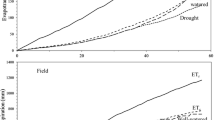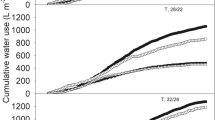Abstract
Crop nitrogen (N) status is known to affect crop water status and crop water use. To investigate further the N effects on soil water changes and on canopy temperature, three water levels × four N levels were imposed on two growing seasons of maize in west central Nebraska, USA. Soil water changes were measured using a neutron probe, whereas canopy temperature was measured using infrared thermometers on a ground-based mobile platform. At all water levels, soil water losses over month-long intervals were generally greater as N levels increased. Given equal water levels, early afternoon canopy temperatures were usually lower with higher N levels, but no trend or even the opposite trend was occasionally observed. Jointly considering canopy reflectance and soil water depletion shows potential to explain much of the variation in estimated instantaneous water use among plots. However, determining the relative contributions of the canopy and soil factors on a particular day may require season-to-date knowledge of the crop. Further research on assimilating such sensor data for a combined stress coefficient would improve crop modeling and irrigation scheduling when variable water sufficiency and variable N sufficiency are simultaneously significant.






Similar content being viewed by others
References
Abendroth LJ, Elmore RW, Boyer MJ, Marlay SK (2011) Corn growth and development. Iowa State University, Ames
Albrizio R, Todorovic M, Matic T, Stellacci AM (2010) Comparing the interactive effects of water and nitrogen on durum wheat and barley grown in a mediterranean environment. Field Crops Res 115(2):179–190. https://doi.org/10.1016/j.fcr.2009.11.003
Allen RG, Wright JL (1997) Translating wind speed measurements from weather stations to agricultural crops. J Hydrol Eng 2(1):26–35. https://doi.org/10.1061/(ASCE)1084-0699(1997)2:1(26)
Barker JB, Heeren DM, Neale CMU, Rudnick DR (2018) Evaluation of variable rate irrigation using a remote-sensing-based model. Agric Water Manag 203:63–74. https://doi.org/10.1016/j.agwat.2018.02.022
Bates D, Maechler M, Bolker B, Walker S (2015) Fitting linear mixed-effects models using lme4. J Stat Softw 67(1):1–48. https://doi.org/10.18637/jss.v067.i01
Bausch WC, Neale CMU (1987) Crop coefficients derived from reflected canopy radiation: a concept. Trans ASAE 30(3):703–709. https://doi.org/10.13031/2013.30463
Carroll DA II, Hansen NC, Hopkins BG, DeJonge KC (2017) Leaf temperature of maize and crop water stress index with variable irrigation and nitrogen supply. Irrig Sci 35(6):549–560. https://doi.org/10.1007/s00271-017-0558-4
Clawson KL, Blad BL (1982) Infrared thermometry for scheduling irrigation of corn. Agron J 74(2):311–316. https://doi.org/10.2134/agronj1982.00021962007400020013x
Datt B (1999) Visible/near infrared reflectance and chlorophyll content in eucalyptus leaves. Int J Remote Sens 20(14):2741–2759. https://doi.org/10.1080/014311699211778
DeJonge KC, Mefford BS, Chávez JL (2016) Assessing corn water stress using spectral reflectance. Int J Remote Sens 37(10):2294–2312. https://doi.org/10.1080/01431161.2016.1171929
Fois S, Motzo R, Giunta F (2009) The effect of nitrogenous fertiliser application on leaf traits in durum wheat in relation to grain yield and development. Field Crops Res 110(1):69–75. https://doi.org/10.1016/j.fcr.2008.07.004
Gheysari M, Mirlatifi SM, Bannayan M, Homaee M, Hoogenboom G (2009) Interaction of water and nitrogen on maize grown for silage. Agric Water Manag 96(5):809–821. https://doi.org/10.1016/j.agwat.2008.11.003
González-Dugo MP, Moran MS, Mateos L, Bryant R (2006) Canopy temperature variability as an indicator of crop water stress severity. Irrig Sci 24:233–240. https://doi.org/10.1007/s00271-005-0022-8
González-Dugo V, Durand J-L, Gastal F (2010) Water Deficit and nitrogen nutrition of crops: a review. Agron Sustain Dev 30(3):529–544. https://doi.org/10.1051/agro/2009059
Halekoh U, Højsgaard S (2014) A Kenward–Roger approximation and parametric bootstrap methods for tests in linear mixed models: the R package pbkrtest. J Stat Softw 59(9):1–32. https://doi.org/10.18637/jss.v059.i09
Han M, Zhang H, DeJonge KC, Comas LH, Trout TJ (2016) Estimating maize water stress by standard deviation of canopy temperature in thermal imagery. Agric Water Manag 177:400–409. https://doi.org/10.1016/j.agwat.2016.08.031
Jackson RD, Kustas WP, Choudhury BJ (1988) A Reexamination of the crop water stress index. Irrig Sci 9(4):309–317. https://doi.org/10.1007/BF00296705
Klocke NL, Watts DG, Schneekloth JP, Davison DR, Todd RW, Parkhurst AM (1999) Nitrate leaching in irrigated corn and soybean in a semi-arid climate. Trans ASAE 42(6):1621–1630. https://doi.org/10.13031/2013.13328
Kranz WL, Irmak S, van Donk SJ, Yonts CD, Martin DL (2008) Irrigation management for corn. NebGuide G1850. University of Nebraska–Lincoln Extension, Lincoln. Retrieved from https://extensionpublications.unl.edu/assets/pdf/g1850.pdf
Kustas WP, Anderson MC, Norman JM, Li F (2007) Utility of radiometric-aerodynamic temperature relations for heat flux estimation. Bound Layer Meteorol 122(1):167–187. https://doi.org/10.1007/s10546-006-9093-1
Kuznetsova A, Brockhoff PB, Christensen RHB (2017) lmerTest package: tests in linear mixed effects models. J Stat Softw 82(13):1–26. https://doi.org/10.18637/jss.v082.i13
Lenka S, Singh AK, Lenka NK (2009) Water and nitrogen interaction on soil profile water extraction and et in maize–wheat crop** system. Agric Water Manag 96(2):195–207. https://doi.org/10.1016/j.agwat.2008.06.014
Lo T, Rudnick DR, Krienke BT, Heeren DM, Ge Y, Shaver TM (2019) Water effects on optical canopy sensing for late-season site-specific nitrogen management of maize. Comput Electron Agric 162:154–164. https://doi.org/10.1016/j.compag.2019.04.006
Mansouri-Far C, Modarres Sanavy SAM, Saberali SF (2010) Maize yield response to deficit irrigation during low-sensitive growth stages and nitrogen rate under semi-arid climatic conditions. Agric Water Manag 97(1):12–22. https://doi.org/10.1016/j.agwat.2009.08.003
Mon J, Bronson KF, Hunsaker DJ, Thorp KR, White JW, French AN (2016) Interactive effects of nitrogen fertilization and irrigation on grain yield, canopy temperature, and nitrogen use efficiency in overhead sprinkler-irrigated durum wheat. Field Crops Res 191:54–65. https://doi.org/10.1016/j.fcr.2016.02.011
Moran MS, Clarke TR, Inoue Y, Vidal A (1994) Estimating crop water deficit using the relation between surface-air temperature and spectral vegetation index. Remote Sens Environ 49(3):246–263. https://doi.org/10.1016/0034-4257(94)90020-5
Nielsen DC, Halvorson AD (1991) Nitrogen fertility influence on water stress and yield of winter wheat. Agron J 83(6):1065–1070. https://doi.org/10.2134/agronj1991.00021962008300060025x
Ogola JBO, Wheeler TR, Harris PM (2002) Effects of nitrogen and irrigation on water use of maize crops. Field Crops Res 78(2–3):105–117. https://doi.org/10.1016/S0378-4290(02)00116-8
Pandey RK, Maranville JW, Chetima MM (2000) Deficit irrigation and nitrogen effects on maize in a Sahelian environment: II. shoot growth, nitrogen uptake and water extraction. Agric Water Manag 46(1):15–27. https://doi.org/10.1016/S0378-3774(00)00074-3
Peñuelas J, Filella I, Serrano L, Savé R (1996) Cell wall elasticity and water index (R970 nm/R900 nm) in wheat under different nitrogen availabilities. Int J Remote Sens 17:373–382. https://doi.org/10.1080/01431169608949012
R Core Team (2020) R: a language and environment for statistical computing. R Foundation for Statistical Computing, Vienna
Rudnick DR, Irmak S (2014a) Spatial and temporal maize soil water extraction (depletion) dynamics: part II. Impact of water and nitrogen management strategies on soil water extraction. Trans ASABE 57(2):445–462. https://doi.org/10.13031/trans.57.10254
Rudnick DR, Irmak S (2014b) Impact of nitrogen fertilizer on maize evapotranspiration crop coefficients under fully irrigated, limited irrigation, and rainfed settings. J Irrig Drain Eng 140(12):04014039. https://doi.org/10.1061/(ASCE)IR.1943-4774.0000778
Rudnick DR, Irmak S, Djaman K, Sharma V (2017) Impact of irrigation and nitrogen fertilizer rate on soil water trends and maize evapotranspiration during the vegetative and reproductive periods. Agric Water Manag 191:77–84. https://doi.org/10.1016/j.agwat.2017.06.007
Saneoka H, Moghaieb REA, Premachandra GS, Fujita K (2004) Nitrogen nutrition and water stress effects on cell membrane stability and leaf water relations in Agrostis palustris huds. Environ Exp Bot 52(2):131–138. https://doi.org/10.1016/j.envexpbot.2004.01.011
Schlemmer MR, Francis DD, Shanahan JF, Schepers JS (2005) Remotely measuring chlorophyll content in corn leaves with differing nitrogen levels and relative water content. Agron J 97(1):106–112. https://doi.org/10.2134/agronj2005.0106
Seligman NG, Loomis RS, Burke J, Abshahi A (1983) Nitrogen nutrition and canopy temperature in field-grown spring wheat. J Agric Sci 101(3):691–697. https://doi.org/10.1017/S0021859600038727
Shangguan ZP, Shao MA, Dyckmans J (2000) Nitrogen nutrition and water stress effects on leaf photosynthetic gas exchange and water use efficiency in winter wheat. Environ Exp Bot 44(2):141–149. https://doi.org/10.1016/S0098-8472(00)00064-2
Shaver TM, Kruger GR, Rudnick DR (2017) Crop canopy sensor orientation for late season nitrogen determination in corn. J Plant Nutr 40(15):2217–2223. https://doi.org/10.1080/01904167.2017.1346681
Shiratsuchi LS, Ferguson RB, Shanahan JF, Adamchuk VI, Rundquist DC, Marx DB, Slater GP (2011) Water and nitrogen effects on active canopy sensor vegetation indices. Agron J 103(6):1815–1826. https://doi.org/10.2134/agronj2011.0199
Spalding RF, Watts DG, Schepers JS, Burbach ME, Exner ME, Poreda RJ, Martin GE (2001) Controlling nitrate leaching in irrigated agriculture. J Environ Qual 30(4):1184–1194. https://doi.org/10.2134/jeq2001.3041184x
Task Committee on Standardization of Reference Evapotranspiration (2005) In: Allen RG, Walter IA, Elliott RL, Howell TA, Itenfisu D, Jensen ME (eds) The ASCE standardized reference evapotranspiration equation. Environmental and Water Resources Institute of the American Society of Civil Engineers, Reston
Tilling AK, O’Leary GJ, Ferwerda JG, Jones SD, Fitzgerald GJ, Rodriguez D, Belford R (2007) Remote sensing of nitrogen and water stress in wheat. Field Crops Res 104(1–3):77–85. https://doi.org/10.1016/j.fcr.2007.03.023
van Herwaarden AF, Farquhar GD, Angus JF, Richards RA, Howe GN (1998) “Haying-Off”, the negative grain yield response of dryland wheat to nitrogen fertiliser: I. Biomass, grain yield, and water use. Aust J Agric Res 49(7):1067–1082. https://doi.org/10.1071/A97039
Ward NC (2015) Nitrogen and water effects on canopy sensor measurements for site-specific management of crops (Doctoral dissertation). University of Nebraska–Lincoln, Lincoln, NE. Retrieved from https://digitalcommons.unl.edu/cgi/viewcontent.cgi?article=1094&context=agronhortdiss
Wright JL (1982) New evapotranspiration crop coefficients. J Irrig Drain Div 108(1):57–74
Yang DQ, Dong WH, Luo YL, Song WT, Cai T, Li Y, Yin YP, Wang ZL (2018) Effects of nitrogen application and supplementary irrigation on canopy temperature and photosynthetic characteristics in winter wheat. J Agric Sci 156(1):13–23. https://doi.org/10.1017/S0021859617000946
Acknowledgements
The authors are grateful to Turner Dorr, Jacob Nickel, Odile Umuhoza, Raïssa Urujeni, Von Fritsche, Jasreman Singh, and Roberto Arellano-Choca for their involvement with data collection; to Gary Mahnken and Merle Still for their supporting roles in field management; to Holland Scientific, Lindsay Corporation, Holzfasters Irrigation, and SureFire Ag Systems for their timely technical support; to Nebraska State Climate Office for their Nebraska Mesonet weather data; and to Debbie Boykin for her statistical consulting. This study is based upon work that was jointly supported by the United States Department of Agriculture’s National Institute of Food and Agriculture under award numbers 2016-68007-25066 and 2017-68007-26584 and under Hatch projects #1009760 and #1015698; the United States Department of Agriculture's Agricultural Research Service under cooperative agreement number 58-6001-7-001; the Nebraska Corn Board under award number 88-R-1617-06; the Daugherty Water for Food Global Institute; and the University of Nebraska–Lincoln Institute of Agriculture and Natural Resources.
Author information
Authors and Affiliations
Corresponding author
Ethics declarations
Conflict of interest
On behalf of all authors, the corresponding author states that there is no conflict of interest.
Additional information
Publisher's Note
Springer Nature remains neutral with regard to jurisdictional claims in published maps and institutional affiliations.
Rights and permissions
About this article
Cite this article
Lo, T., Rudnick, D.R., DeJonge, K.C. et al. Differences in soil water changes and canopy temperature under varying water × nitrogen sufficiency for maize. Irrig Sci 38, 519–534 (2020). https://doi.org/10.1007/s00271-020-00683-2
Received:
Accepted:
Published:
Issue Date:
DOI: https://doi.org/10.1007/s00271-020-00683-2




